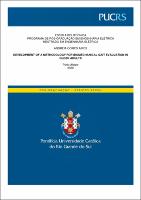| Share record |


|
Please use this identifier to cite or link to this item:
https://tede2.pucrs.br/tede2/handle/tede/9336| Document type: | Dissertação |
| Title: | Development of a methodology for biomechanical gait evaluation in older adults |
| Author: | Aires, Andreia Gomes |
| Advisor: | Baptista, Rafael Reimann |
| Abstract (native): | Changes in the demographic profile of Brazil and the world serve as a motivation to direct attention to the population that has been changing the shape of the age pyramid, the elderly. Assessing the functional capacity of older adults is crucial to determine their level of independence and verify the potential that these individuals must perform their activities of daily living. Since functional capacity means the ability of an individual to maintain the physical and mental functions required to preserve their independence, assessing how older adults walk is essential to ensure that this activity of daily living is carried out safely. The determination of this level of functionality can be performed through the study of ground reaction forces (GRF) during the gait cycle, which is often performed in a qualitative way, making the results highly subjective and without standardization. In this context, the objective of this work was to develop a methodology for identifying and quantifying the main parameters that characterize the vertical and anterior-posterior curves of the GRF. This methodology was created using a database containing raw data from walking tests performed by 33 participants. The force signals used to perform the biomechanical assessment of gait in the elderly were captured by 8 force platforms, composed of 12 strain gauges each. An algorithm was developed for processing the GRF signal, transforming the raw force data into discrete gait parameters. As a result, the methodology delivers the values of the first vertical peak force, the lowest force between the two maximums vertical peak force, the second vertical peak force, braking peak, propulsion peak, as well as the times for these gait events. The impulses of the vertical and anterior-posterior forces were also calculated through the area under the force-time curve. Additionally, the values found in the processing of data from the elderly database, using the proposed methodology, were compared with other studies that also evaluated ground reaction forces in the elderly population. The development of this methodology proved to be efficient in the evaluation of kinetic and temporal parameters related to the gait of older adults. In addition, it will serve as an important tool for biomechanical analysis of the gait of different populations, providing new investigations and evaluations. |
| Abstract (english): | As alterações no quadro demográfico do Brasil e do mundo servem como motivação para direcionar a atenção nos indivíduos responsáveis pela alteração da distribuição populacional, os idosos. Avaliar a capacidade funcional do idoso é fundamental para determinar seu nível de independência e com isso verificar qual o potencial que estes indivíduos possuem para executar suas atividades do dia a dia. A determinação deste nível de funcionalidade pode ser realizada através do estudo das Forças de Reação do Solo (FRS) durante o ciclo da marcha, que muitas vezes é realizada de forma qualitativa, tornando os resultados altamente subjetivos e sem padronização. Neste contexto, o objetivo deste trabalho foi desenvolver uma metodologia capaz de identificar e quantificar os principais parâmetros que caracterizam as curvas vertical e ântero-posterior das FRS. Para o desenvolvimento desta metodologia, um banco de dados contendo dados força e tempo de testes de caminhada realizados por 33 participantes foi utilizado. As informações referentes aos sinais biomédicos utilizados para a realização da avaliação biomecânica da marcha de idosos foram capturados por 8 plataformas de força, compostas por 12 sensores de força cada. A análise e o tratamento dos dados brutos de força foram realizados com o auxílio de um algoritmo desenvolvido para o processamento do sinal de FRS. Como resultado foram identificados e calculados os valores do primeiro pico de força vertical, da menor força entre os picos de força vertical, do segundo pico de força vertical, pico de frenagem da força ântero-posterior, pico de propulsão da força ânteroposterior, bem como os tempos para estes eventos da marcha. Os impulsos das forças verticais e ântero-posteriores também foram calculados através da área abaixo da curva de força pelo tempo. Adicionalmente, os valores encontrados no processamento dos dados provenientes do banco de dados de idosos, utilizando a metodologia proposta, foram comparados com outros estudos que também avaliaram as forças de reação do solo na população idosa. O desenvolvimento desta metodologia mostrou-se eficiente na avaliação de parâmetros cinéticos e temporais relacionados a marcha de idosos. Além disso, servirá como importante ferramenta para análise biomecânica da marcha de diferentes populações proporcionando novas investigações e avaliações. |
| Keywords: | Gait analysis Biomechanics Ground reaction forces Older adults Análise de marcha Biomecânica Forças de reação do solo Idosos |
| CNPQ Knowledge Areas: | ENGENHARIAS |
| Language: | eng |
| Country: | Brasil |
| Publisher: | Pontifícia Universidade Católica do Rio Grande do Sul |
| Institution Acronym: | PUCRS |
| Department: | Escola Politécnica |
| Program: | Programa de Pós-Graduação em Engenharia Elétrica |
| Access type: | Acesso Aberto |
| Fulltext access restriction: | Trabalho não apresenta restrição para publicação |
| URI: | http://tede2.pucrs.br/tede2/handle/tede/9336 |
| Issue Date: | 31-Mar-2020 |
| Appears in Collections: | Programa de Pós-Graduação em Engenharia Elétrica |
Files in This Item:
| File | Description | Size | Format | |
|---|---|---|---|---|
| ANDRÉIA GOMES AIRES_DIS.pdf | ANDREIA_GOMES_AIRES_DIS | 4.18 MB | Adobe PDF |  Download/Open Preview |
Items in DSpace are protected by copyright, with all rights reserved, unless otherwise indicated.




